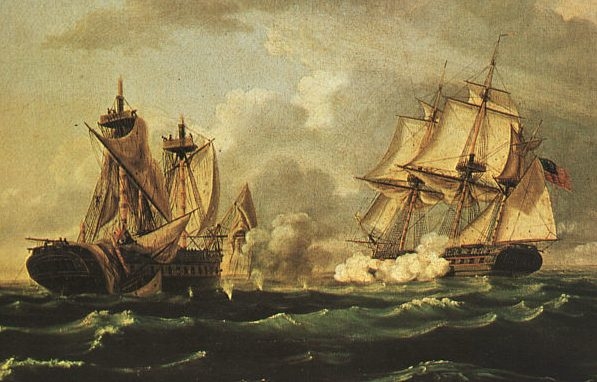This cache is not at the listed coordinates! Solve this
puzzle to find the actual coordinates:
United States was launched on 10 May 17XY.
United States was finally broken up in 186Z.
A = (X + Y ) / 2
B = Z
N35 36.72A W84 41.41B
The Anchors Aweigh series was placed in honor of the men of the
US Navy who have served in the defense of our country. Each cache
is dedicated to one of the warships involved in battle. If you find
all the caches in the series, you’ll reveal some nice GeoArt
on your cache map. These are not difficult caches to find. If you
cannot find a cache easily, it’s probably missing. Send me a
picture (by email, not in your log) of where you think the cache
should be, and I’ll accept the find and replace the
cache.
Because of the difficulty in finding suitable locations for some
of the caches, some puzzle caches were used so that the find icon
could be in a location separate from the cache. You should be able
to solve the puzzles with information on this cache page. I suggest
you solve the puzzles before you make your cache run, to help
optimize the route.
USS United States
USS United States was a nominally rated 44-gun
wooden-hulled, three-masted heavy frigate of the United States
Navy. Joshua Humphreys designed these frigates to be the young
Navy's capital ships, and so United States and her sisters
were larger and more heavily armed and built than standard frigates
of the period. She was built at Humphrey's shipyard in
Philadelphia, Pennsylvania, launched on 10 May 1797, and
immediately began duties with the newly formed United States Navy
protecting American merchant shipping during the Quasi-War with
France.
In 1861 the United States was in port at Norfolk and was
seized and subsequently commissioned into the Confederate States
Navy as CSS United States, but was later scuttled by
Confederate forces. Union forces raised the scuttled ship, and
retained control of the ship until it was broken up in 1865.
United States vs Macedonian

While United States was at Norfolk, Captain John S.
Carden of the Royal Navy, commander of the new British frigate HMS
Macedonian, wagered Captain Decatur a beaver hat that his
vessel would take United States if the two should ever meet
in battle. Ichabod B. Crane, whose name was appropriated for the
main character in The Legend of Sleepy Hollow, served under Decatur
as a lieutenant in the Marine detachment aboard ship.
The United States declared war against Britain on 18 June 1812.
Three days later Decatur and United States sailed from New
York City within a squadron under the command of Commodore John
Rodgers in President. Other ships of the squadron were Congress,
Hornet, and Argus; departed on a seventy-day North Atlantic cruise.
A passing American merchant ship informed Rodgers about a fleet of
British merchantmen en route to Britain from Jamaica. Rodgers and
his squadron sailed in pursuit, and on 23 June encountered what was
later learned to be HMS Belvidera.
United States and the squadron returned to pursuing the
Jamaican fleet and on 1 July began to follow the trail of coconut
shells and orange peels the Jamaicans had left behind them.
United States sailed to within one day's journey of the
English Channel but never sighted the convoy. Rodgers called off
the pursuit on 13 July. During their return trip to Boston, the
squadron captured seven merchant ships and recaptured one American
vessel.
After some refitting, United States, still under
Decatur's command, sailed again 8 October with Rodgers but on the
12th parted from the squadron for her own patrol. Three days later,
after capturing Mandarin, United States parted
company and continued to cruise eastward. At dawn, on the 25th,
five hundred miles south of the Azores, lookouts on board United
States reported seeing a sail 12 miles (19 km) to windward. As
the ship rose over the horizon, Captain Decatur made out the
familiar lines of HMS Macedonian.
Both ships were immediately cleared for action and commenced
maneuvers at 0900. Captain Carden elected not to risk crossing the
bows of United States to rake her, but chose instead to haul
closer to the wind on a parallel course with the American vessel.
For his part, Decatur intended to engage Macedonian from
fairly long range, where his 24 pounders (11 kg) would have the
advantage over the 18 pounders (8 kg) of the British.
The actual battle developed according to Decatur's plan.
United States began the action at 0920 by firing an
inaccurate broadside at Macedonian. This was answered
immediately by the British vessel, bringing down a small spar of
United States. Decatur's next broadside destroyed
Macedonian's mizzen top mast, letting her driver gaff fall
and so giving the advantage in maneuver to the American frigate.
United States next took up position off Macedonian's
quarter and proceeded to riddle her with shot. By noon,
Macedonian was a dismasted hulk and was forced to surrender.
She had suffered 104 casualties against 12 in United States,
which emerged from the battle relatively unscathed.
The two ships lay alongside each other for over two weeks while
Macedonian was repaired sufficiently to sail. United
States and her prize entered New York Harbor on 4 December amid
jubilation over the victory. Captain Decatur and his crew were
received with praise from both Congress and President James
Madison.